Top Five Offloader Knee Braces
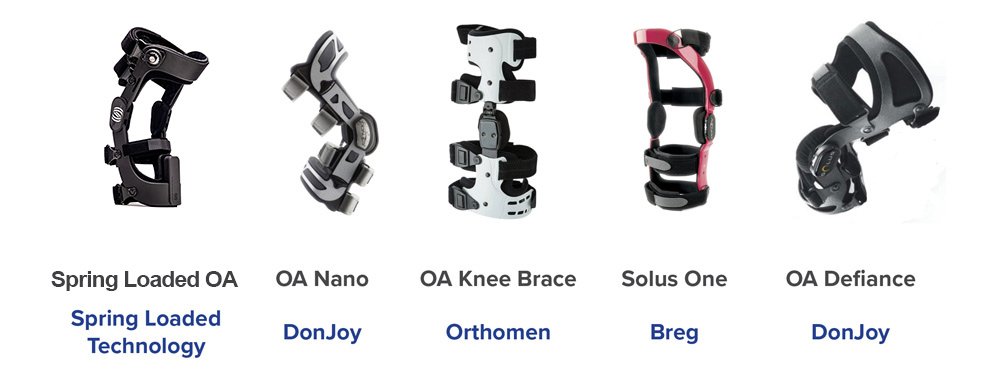
Thinking about purchasing an offloader knee brace to help with your arthritis? We break down the best and most popular products so you don’t have to.
Popular Offloader Knee Braces
Offloader knee braces can provide powerful relief from osteoarthritis (OA) symptoms. Considered one of the best conservative options out there for treating OA, offloader knee braces can dramatically delay or eliminate the need for knee replacement surgery. They also provide a viable alternative to pharmaceutical drugs and painkillers. This is an attractive option for those looking to avoid the potentially dangerous side-effects associated with the long term use of medications.
If you search for the term “offloader knee brace” using Google you will find almost 20,000 results. That’s an intimidating amount of products and information to sift through. To make your life easier we have broken down the product features and compared five of the most popular braces on the market.
Offloader Knee Brace Comparison
If you haven’t purchased an offloader knee brace in the past, it can be confusing to decipher the differences between products. It is important to realize that depending on the type of osteoarthritis you have some braces may provide much greater benefit than others.
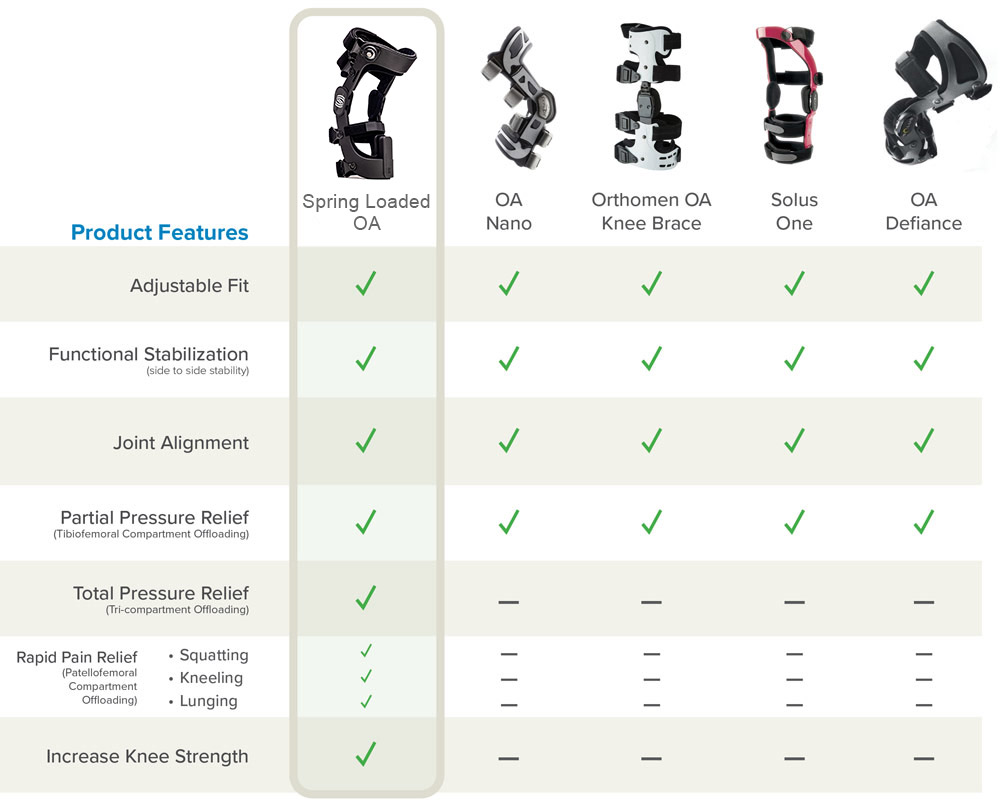
Adjustable Fit
As you probably already know osteoarthritis can be very painful, often resulting in the habitual avoidance of placing weight on the injured knee. Overtime disuse of the knee and a more sedentary lifestyle can lead to muscle atrophy around the thigh muscles. If you start exercising or working with a physical therapist or trainer, it is possible to regain the lost muscle mass. Given that your thigh may fluctuate in size over time it is important that your brace be adjustable. Interchangeable padding and customizable straps can both help to ensure your brace fits you properly for the long term. Most offloader knee braces are customizable to some degree. While most braces come in different sizes, some of them like the Breg Solus One and Donjoy OA Defiance can be customized and molded specifically to your leg.
Functional Stabilization (Side-to-Side Stability)
While walking, hiking or going up and down stairs, you may have experienced a feeling of instability in your knee. More specifically, due to malaligned joints and specific muscle weakness, the knee joint often has the tendency to collapse inwards (valgus) or less commonly outwards (varus). An offloader knee brace with a rigid carbon fiber frame provides support that stops your knee joint from collapsing laterally. This can help you feel more secure when traversing uneven or unpredictable terrain.
Knee Joint Alignment
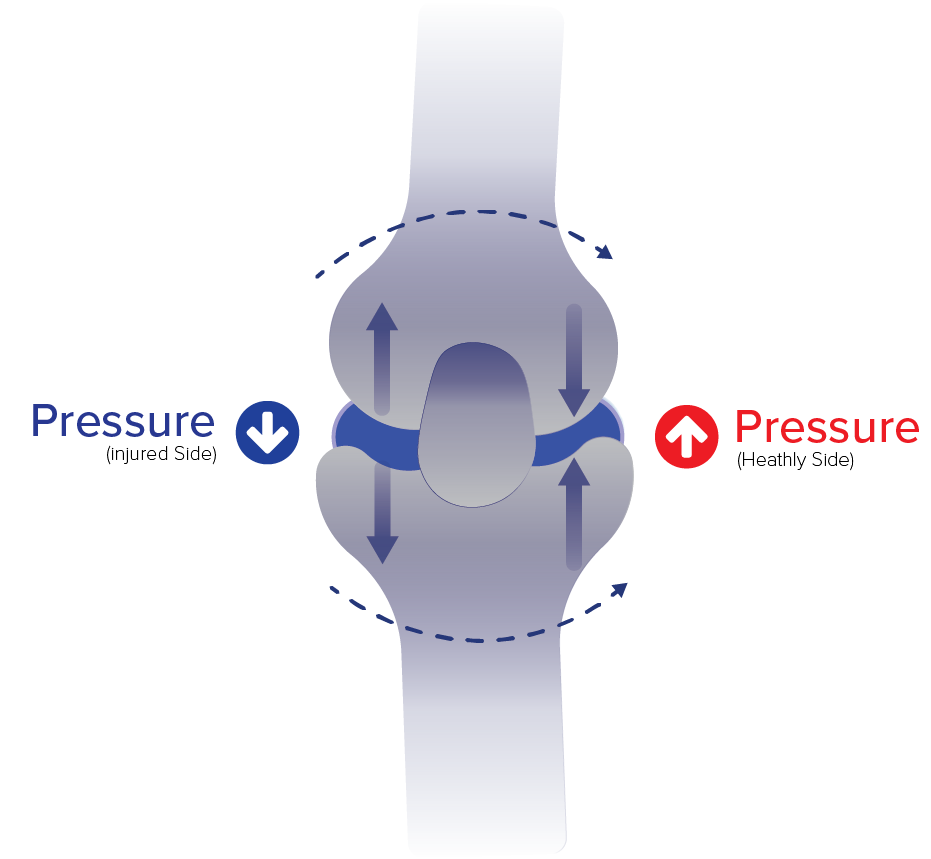
A malaligned knee joint is one of the possible contributors to the development of osteoarthritis.1 The poor alignment is usually due to a varus deformity (bow-legged appearance) or valgus deformity (knock knee appearance). Offloader knee braces can help correct this by repositioning the knee joint. Using a tension strapping system, offloader knee braces actively pull one side of the knee up, while pressing the other side down. This can put the joint into a better position – allowing for more equal pressure distribution on the cartilage.
Partial Pressure Relief (Unicompartment Offloading)
The pain and disability accompanying advanced knee osteoarthritis is the result of inflammation caused by bone on bone friction within the joint. In areas of your knee where the cartilage has worn down, increased pressure creates inflammation and joint irritation. Offloader knee braces can help by re-aligning the joint to take the pressure off these areas.
As discussed earlier, they do this by re-aligning the knee joint via the braces strapping system. This is an effective solution for those that have unicompartmental osteoarthritis in either the lateral tibiofemoral compartment or the medial tibiofemoral compartment.
The number of individuals with osteoarthritis in a single knee compartment is lower than those presenting with degeneration in multiple areas of the knee. Recent studies showed that among patients with knee osteoarthritis:
- 50–94% had osteoarthritis in multiple compartments or in the patellofemoral compartment of the knee.2, 3, 4, 5
- 3–20% had osteoarthritis in only one tibiofemoral compartment of the knee.3, 6, 7
- One study suggests that as few as 6% of knee osteoarthritis patients have the disease isolated to one tibiofemoral compartment.3
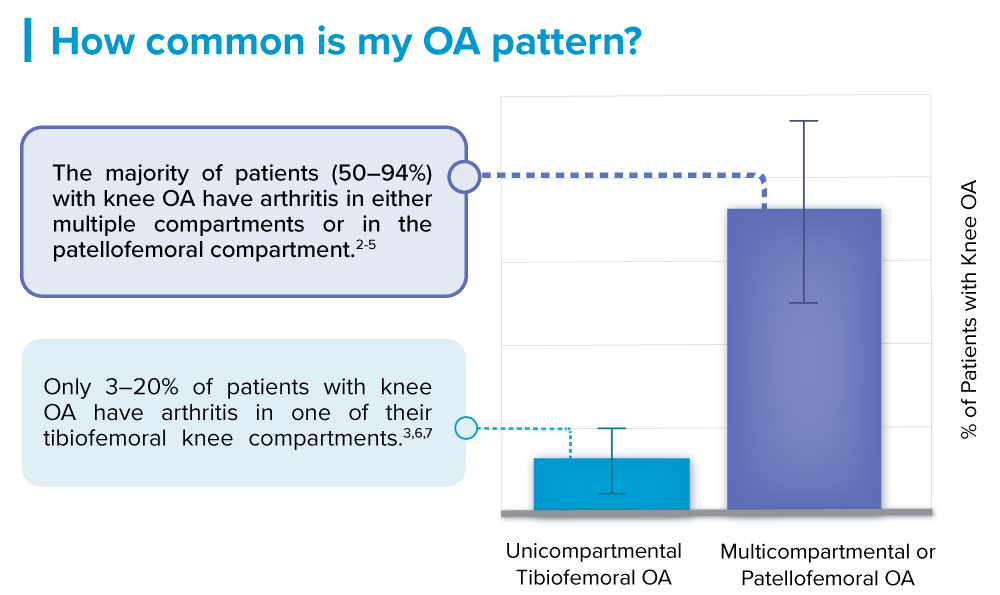
What does this mean? The majority of patients with severe knee osteoarthritis require offloading of multiple knee compartments (total pressure relief), while only a minority of patients will benefit from a traditional uni-compartment offloading (partial pressure relief).
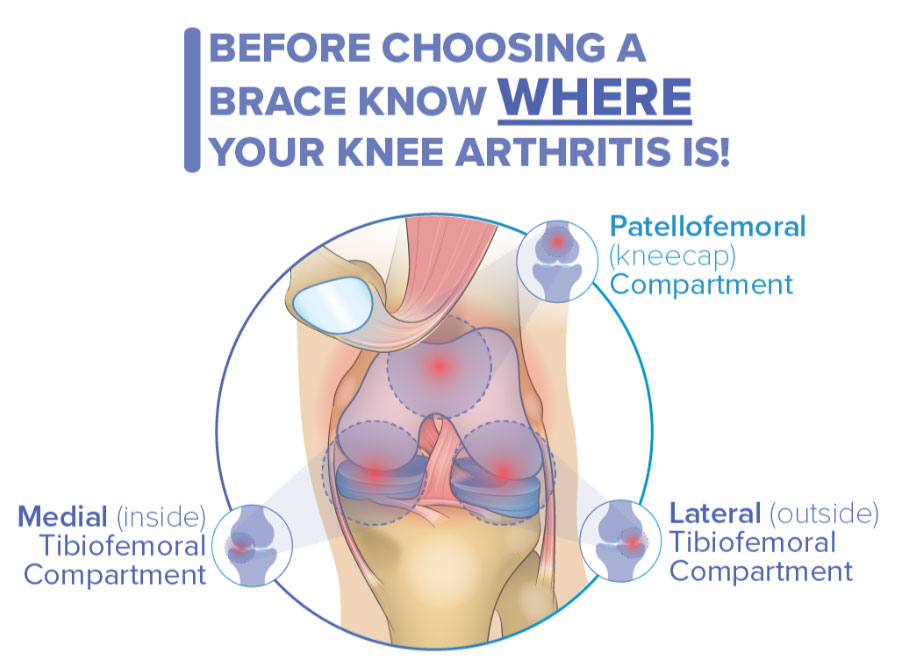
Total Pressure Relief (Tricompartment Offloading)
Tri-compartment Offloading means that all three pressure points of the knee are offloaded simultaneously. This has benefits for all arthritic areas of the knee joint, not just one. Just like weight loss, pressure across the entire knee joint is reduced resulting in less pain and a possible slower rates of disease progression.

Contemporary bracing technology focuses on helping patients with uni-compartment osteoarthritis, as it redistributes rather than reduces pressure within the knee. Spring Loaded’s Levitation®2 uses a spring-loaded hinge, which actively absorbs force as the knee is bent – taking the pressure off the entire joint. As far as your knee is concerned this is the equivalent of instantly losing a significant amount of bodyweight. In fact, a recent biomechanical study suggests that the Levitation knee brace can reduce joint contact forces by over 40% (at 90 degrees of knee flexion).8
Pain Relief – Squatting, Lunging, Kneeling (Patellofemoral Offloading)
If you have osteoarthritis in the patellofemoral compartment of your knee, you likely experience difficulty when getting into a deep knee bend. As your knee bends the pressure between the back of your kneecap and the rest of the joint increases dramatically. Braces that provide only tibiofemoral compartment offloading will not be very effective in helping with this issue. The Levitation knee brace, due to its spring hinge, is better suited to deal with the issue. The more you bend your knees, the more the springs compress, supporting you during movements such as squatting, lunging and kneeling.
Increase Strength
Do you have difficulty getting in and out chairs? Walking up stairs? If so your knee pain is likely negatively impacting your knee strength. This is a problem that an offloader knee brace is typically not capable of solving. Strength enhancement is more in the domain of exoskeleton technology than knee braces. Currently the Levitation knee brace, again owing to its spring hinge technology, is the only offloader knee brace that augments joint strength as you bend your knees.
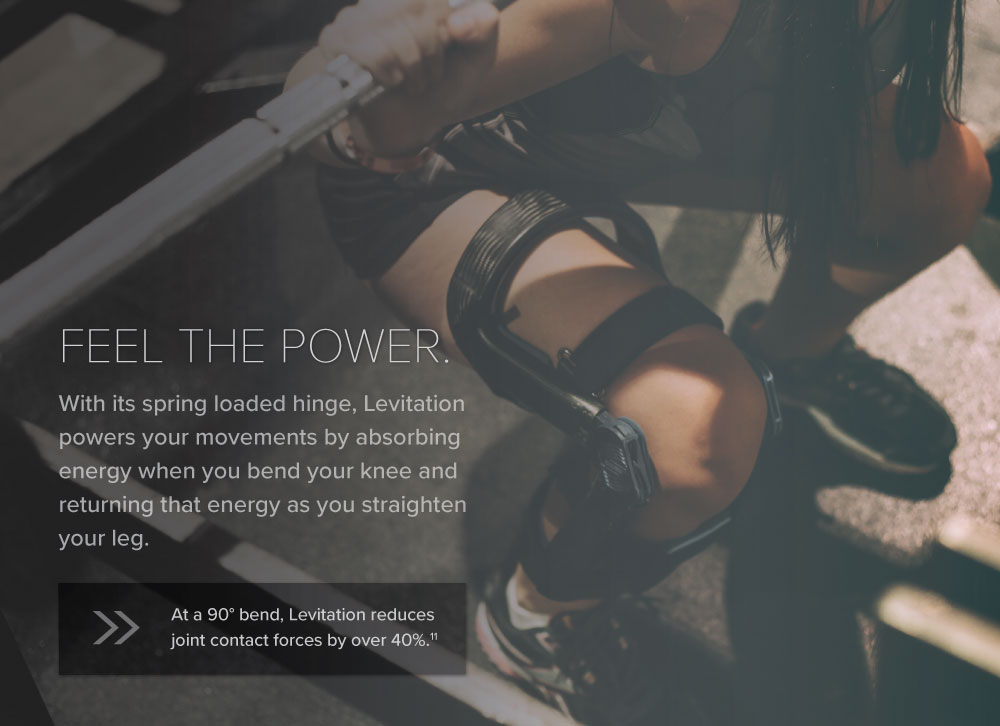
For more in-depth comparisons of traditional offloader knee braces and Levitation, take a look at these resources below:
Which Offloader Knee Brace is Right for You?
If you have uni-compartment tibiofemoral osteoarthritis, there are many offloader knee braces that could provide you with benefits. Here you should compare price, aesthetic appeal and comfort.
However, if like most individuals you have multi-compartment OA, there is really only one viable option – Levitation.
Tri-compartment offloading is an exciting new treatment for severe knee osteoarthritis. With this mechanism, damaged areas can be offloaded rather than replaced. A new type of exoskeleton hybrid knee brace uses spring technology to provide additional support to the knee, reducing joint contact forces by over 40%.8
In addition, tri-compartment offloading has been shown to provide substantial improvements in pain and pressure reduction and increased mobility. Among Spring Loaded customers with knee osteoarthritis who bought the Levitation 2 brace, 95% reported they experienced reduced pain9 and 85% reported they experienced increased mobility.10
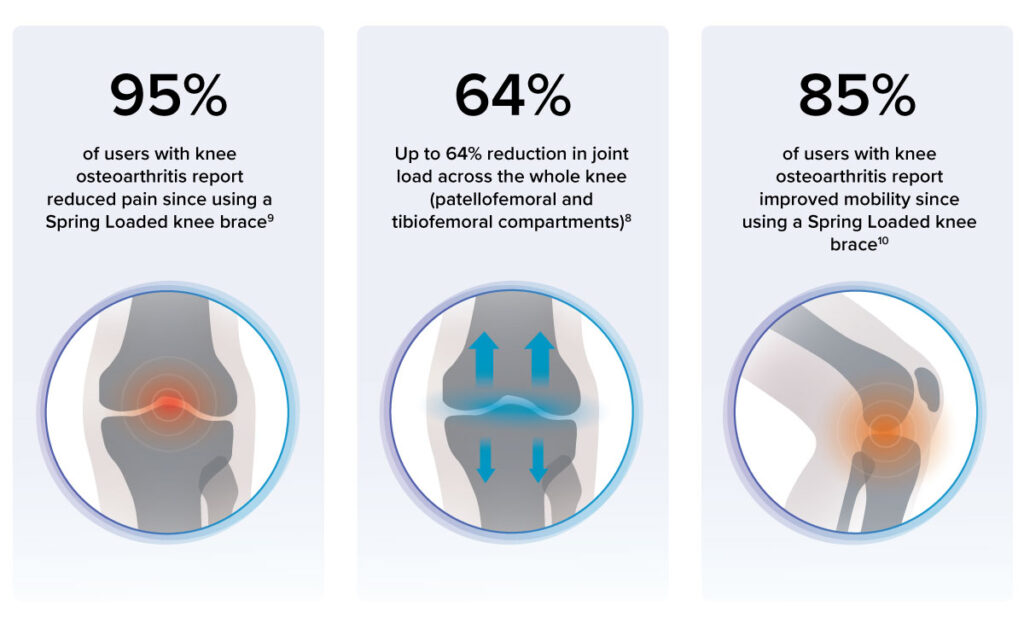
To learn more about this innovation, click the button below.
Or learn more about tri-compartment offloader braces here
More Reading
Want more information to help you choose your bracing solution?
- Choosing a Knee Brace – Everything You Need to Know
- The Best Hinged Knee Brace for Your Needs
- The Best Knee Brace for Osteoarthritis
- The Best Knee Brace for Meniscus Tears
References
- Hunter, D. J., Sharma, L., & Skaife, T. (2009). Alignment and osteoarthritis of the knee. JBJS, 91(Supplement_1), 85-89.
- McAlindon, T., Zhang, Y,, Hannan, M., Naimark, A., Weissman, B., Castelli, W., & Felson, D. (1996). Are risk factors for patellofemoral and tibiofemoral knee osteoarthritis different?. J Rheumatol, 23(2), 332-337.
- Duncan, R. C., Hay, E. M., Saklatvala, J., & Croft, P. R. (2006). Prevalence of radiographic osteoarthritis – it all depends on your point of view. Rheumatology, 45(6), 757–760. doi: 10.1093/rheumatology/kei270.
- Stefanik, J. J., Guermazi, A., Roemer, F.W., et al. (2016). Changes in patellofemoral and tibiofemoral joint cartilage damage and bone marrow lesions over 7 years: the Multicenter Osteoarthritis Study. Osteoarthritis Cartilage, 24(7), 1160-1166. doi:10.1016/j.joca.2016.01.981.
- Lankhorst, N.E., Damen, J., Oei, E.H, et al. (2017). Incidence, prevalence, natural course and prognosis of patellofemoral osteoarthritis: the Cohort Hip and Cohort Knee study. Osteoarthritis Cartilage, 25(5), 647-653. doi:10.1016/j.joca.2016.12.006.
- Heekin, R. D., & Fokin, A. A. (2014). Incidence of bicompartmental osteoarthritis in patients undergoing total and unicompartmental knee arthroplasty: is the time ripe for a less radical treatment?. The journal of knee surgery, 27(01), 077-082.
- Shahid, M. K., Al-Obaedi, O., & Shah, M. (2018). Prevalence of compartmental osteoarthritis of the knee in an adult patient opulation: A retrospective observational study. EC Orthopaedics, 9(10), 774–780.
- McGibbon, C. & Mohamed, A. Knee Load Reduction From an Energy Storing Mechanical Brace. Canadian Society for Biomechanics (2018).
- Based on a retrospective survey of Spring Loaded brace users with knee osteoarthritis.
- Based on a retrospective survey of Spring Loaded brace users with knee osteoarthritis.
- Based on a retrospective survey of Spring Loaded brace users with knee osteoarthritis.
Frequently Asked Questions
There are two categories of offloader knee braces: Uni-compartment and tri-compartment offloaders. The former are designed to decrease arthritis pain in individuals suffering from uni-compartment tibiofemoral knee arthritis. Tri-compartment offloading braces are for individuals with arthritis in multiple areas of the knee or under the kneecap.
Both strap-tensioning and spring-based systems can reduce load on the knee, albeit in different ways. Traditional strap-tensioning systems redistribute pressure from the arthritic area of the knee to healthy areas of the joint. Spring-based systems redistribute pressure away from the knee joint to the thigh and calf.
Scientific analysis of tri-compartment offloader knee braces show that they relieve joint pressure equivalent to 45-lbs of weight-loss. Most experts agree that weight-loss is the gold standard treatment knee arthritis treatment, however it can be difficult to achieve and maintain. Tri-compartment offloader knee braces offer a viable alternative to those who struggle exercise and weight-loss regimes.